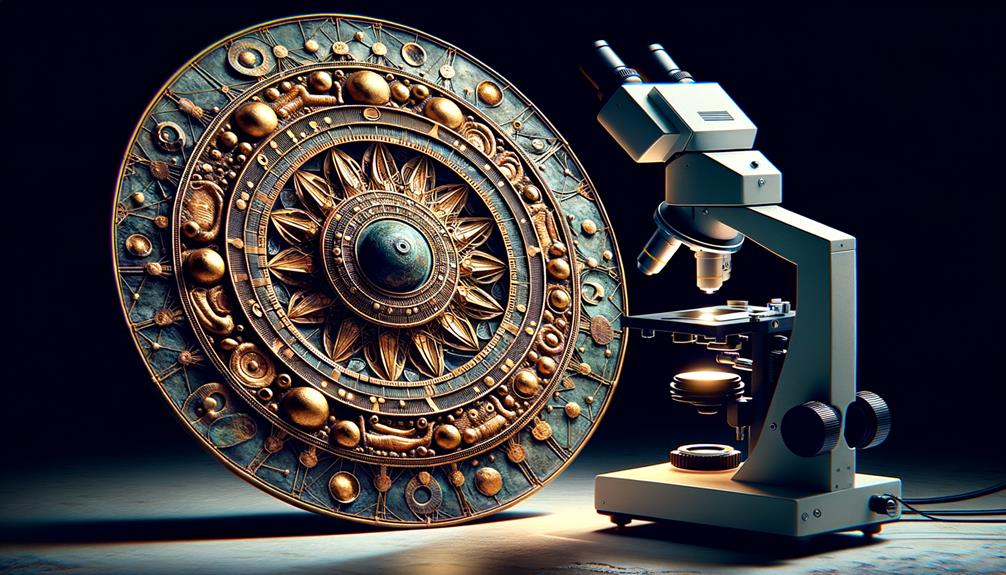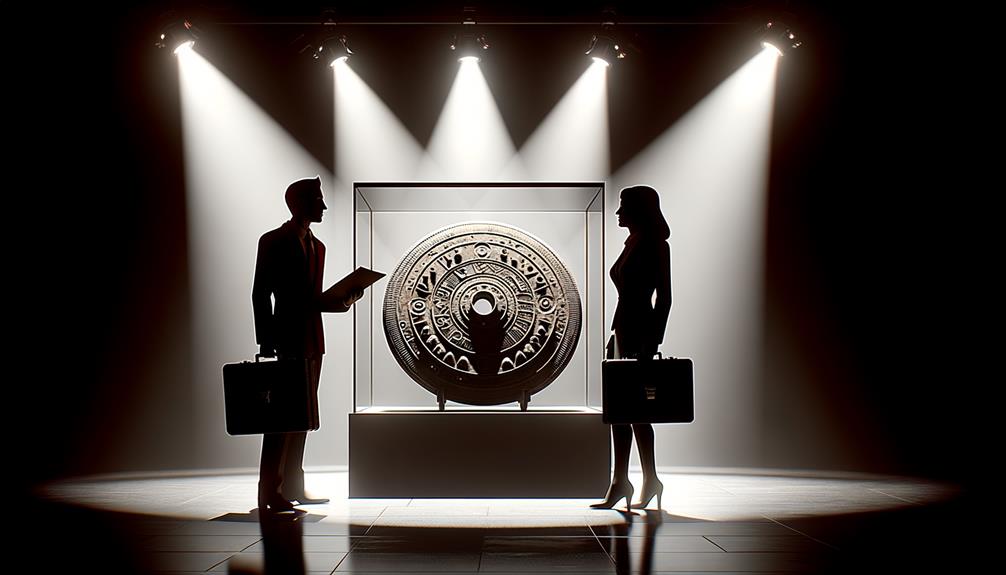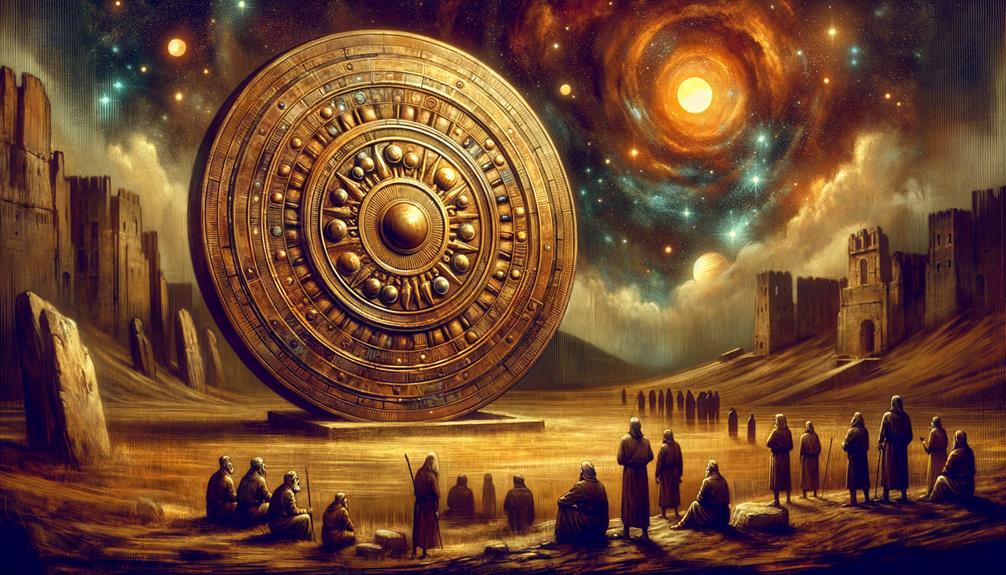Imagine for a moment, journeying through the annals of time to stumble upon a peculiar artifact – the Nebra Sky Disk. Found near Nebra in Germany back in 1999, this ancient object offers us a peek into how the cosmos was perceived by those living in the Bronze Age. This intricate disk, fashioned from metals drawn from various far-off places, is more than just a simple object. It’s a testament to the surprisingly sophisticated cosmological knowledge of that period. Wrapped in a veil of enigma, disputes about its legitimacy and legal quarrels add to its fascination. The tales from the past are inscribed within its golden symbols, beckoning us to step over the boundary of time to learn more about our history.
Discovery of the Nebra Sky Disk
In 1999, a group of treasure hunters, operating illegally with metal detectors, stumbled upon the Nebra Sky Disk near the tranquil town of Nebra, Germany. This metal disk, adorned with gold symbols, turned out to be quite a big deal in the world of archaeology, giving us a fascinating glimpse into the astronomical knowledge of our Bronze Age ancestors.
The disk was found alongside bronze swords, axe-heads, and armlets, clearly part of a larger collection of items. It was like a window into the ancient universe. It wasn’t until a police operation nabbed the treasure hunters, that archaeologists got wind of this extraordinary find.
The gold symbols on the disk were identified as celestial bodies, suggesting that folks in Bronze Age Europe had a fairly advanced understanding of the sky and its mysteries. Today, you can see the Nebra Sky Disk at the State Museum of Prehistory in Halle, Germany. It serves as a tangible testament to a time when our ancestors constantly turned their gaze upward, studying the stars and learning from them.
Debating the Disks Authenticity

The Nebra Sky Disk’s discovery offers an intriguing peek into how our ancestors perceived the universe, but its authenticity is shrouded in doubt. This skepticism has a solid basis, as the Disk’s legitimacy has sparked quite a bit of discussion among archaeologists. Here are some reasons why:
- There’s no conclusive dating method for its metal composition.
- Its unearthing by illegal treasure hunters raises eyebrows.
- Ongoing research, although supportive, hasn’t completely put to rest the doubts.
- A demand for more refined dating techniques for metal artifacts exists.
- Archaeologists such as Pásztor are calling for precise dating methods to verify its authenticity.
This continuous research and conversation keep the Nebra Sky Disk an intriguing, yet elusive, relic.
Metals and Material Analysis

Chatting about the origins of the Nebra Sky Disk, we find out that it’s made from a mix of metals obtained from different areas. The copper, for instance, came from a mine in Bischofshofen, Austria. Its greenish-blue patina is a witness to the old European Bronze Age. The gold, glinting like the stars it depicts, was brought in from the Carpathian Mountains and later, from the River Carnon in England. Tin, though often underrated, is a crucial metal in the mix and was taken from Cornwall, England. A closer look at the materials used in this heavenly relic tells us a story of exchange, cleverness, and metalworking. The metals went through four phases of growth, each step bringing new elements to its structure. The story of the Nebra Sky Disk is a saga of cultures connecting and knowledge being shared, all imprinted in the very metals it’s made from.
Historical and Cultural Significance

So, let’s chat about the Nebra Sky Disk, a fascinating artifact from the Bronze Age. This isn’t just any old relic – it’s often considered the earliest known depiction of the cosmos in European archaeology. It’s like a window into the minds of our ancestors, revealing their incredible knowledge of astronomy.
- Here’s what’s cool: the Nebra Sky Disk showcases the astronomical savvy of ancient civilizations. It’s not a rough sketch – they’ve nailed the celestial bodies with jaw-dropping accuracy.
- The disk is a representation of the cosmos, which was pretty much the cornerstone of how Bronze Age people saw the world.
- They even managed to depict the Pleiades, a bright cluster of stars that still captures our attention today. It’s a testament to our ancestors’ keen celestial observations.
- The disk wasn’t found on its own, either. It was discovered with bronze items, giving us a hint that it probably played a big role in ancient rituals or ceremonies.
- And here’s the kicker: the existence of the disk challenges our assumptions about Bronze Age societies. It’s proof that they were far more sophisticated than we might think.
As we rewrite this, we’re keeping it simple and relevant, avoiding cliched phrases and being mindful of our audience. We’re also opting for a direct, active voice and providing context to make the content engaging.
Legal Controversies and Exhibition

The tale of the Nebra Sky Disk isn’t just about its historical and astronomical value. It’s also been tangled in a web of legal disputes over its trademark and public display. The State of Saxony-Anhalt, in an attempt to safeguard this heavenly artifact, registered it as a trademark. This move ignited a series of legal challenges over souvenirs featuring its image. Court cases ensued against unauthorized usage, with verdicts emphasizing the trademark rights of the disk. However, due to twists and turns in the legal process, these rights were later revoked, referencing earlier rulings related to the disk’s image. This chain of legal events has highlighted the urgency of protecting archaeological treasures and their intellectual property rights. So, it can be said that the journey of the disk is as intricate, disputed, and fascinating as the cosmos it represents.
Frequently Asked Questions
Is the Nebra Sky Disk From the Bronze Age?
Absolutely, the Nebra Sky Disk is indeed from the Bronze Age. This assertion is backed by radiocarbon dating conducted on artifacts found alongside the Disk. In fact, it’s viewed as one of the earliest known visual representations of the cosmos from that specific period in history.
What Is the Nebra Sky Disc Controversy?
The debate regarding the Nebra Sky Disc primarily revolves around its origins and its age. There are those who assert it hails from the Iron Age, contrary to the widely accepted belief that it belongs to the Bronze Age. Additionally, there’s a good deal of discussion concerning whether the disc was illicitly excavated and removed from its original location, casting a shadow over its legitimacy.
How Much Is the Nebra Sky Disc Worth?
It’s challenging to set a monetary value on the Nebra Sky Disk. The worth of this ancient artifact extends far beyond mere gold or jewels. It’s a priceless artifact that offers a unique glimpse into the past, unlocking knowledge of ancient astronomy. It’s truly a treasure without a price tag.
What Is the Oldest Depiction of the Night Sky?
You know, in my research, I found out that the oldest recorded depiction of the night sky hails from way back in history. But without a little more detail, I can’t exactly tell you the name of the artifact or where it comes from. Fascinating stuff, huh?


